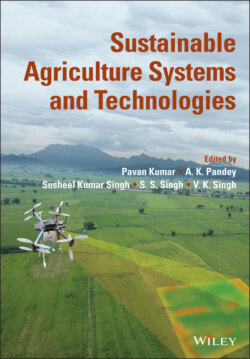Читать книгу Sustainable Agriculture Systems and Technologies - Группа авторов - Страница 30
2.2 The Need for Agricultural Diversification for Sustained Livelihood
ОглавлениеThe size of holdings is declining across the world, more especially in developing countries. In India, almost 86% of the farmers are small and marginal (<1.0 ha) for whom agriculture has become cost‐intensive due to escalating prices of agro‐inputs, labor, and energy, etc. The decreasing landholding size and mono‐cropping types of crop cultivation poses grave challenges to the profitability and overall livelihood of the farmers. Achieving economic sustainability in such agricultural production system necessitates coherent linkage of climate‐smart agriculture with the farmer's needs. In this context, integration of cropping with other farming enterprises under agricultural diversification as integrated farming system (IFS) can ensure enhanced system productivity, resource‐use efficiency, and improved livelihood. Research evidences across the country clearly reveals that the complementary coexistence of diverse crops and other farm enterprises can provide an array of benefits in meeting out the growing demands for food and nutrition rich dietary, income stabilization, and livelihood upliftment while conserving ecological balance and environment, particularly for small holders with limited resources (Singh et al. 2020).
This is of utmost important to maintain ecosystem services adequately for ensuring sustainability in farming. The direct and indirect aids of ecosystems to plant–animal–human continuum are included mainly under the ecosystem services (TEEB 2010). Crop diversification, a type of cropping now has been widely recognized to maintain balance between human needs and ecosystem system services. It is a type of cropping with more number of the crop species. Agricultural diversification can safe guard greater food and nutritional security, minimizing environmental degradation, lessening poverty, higher use efficiency of land resources, and also preventing the impact of degradation forces and helping in contesting desertification. Diversification of agriculture opens new vistas for additional environmentally safe, sustainable systems, enhanced livelihood options for farmers. Some of the crops which are presently considered as underutilized can become a potential tool and hence will ensure more ecologically sustainable agricultural production systems and provide newer livelihood options for small holder farmers. As a matter of the fact global food supply relies on 150 crop species. And the most gruesome challenge is that out of the 150 crops, there are only 12 crops which provide around 75% of the world's food demand. This indicates toward one of the most unsustainable land use types for food production practices in the world. The simple fact that three cereal crops like rice, wheat, and maize are the principal source of more than half of the global food energy and that too from a limited number of varieties of the three “mega‐crops” made the agriecosystems very unsustainable. These cereal crops are also very exhaustive in their demand for nutrients and water, which further complicates the problem of resource degradation.
